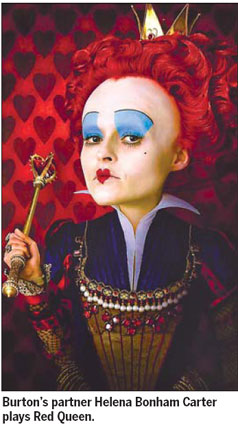Loss and longing in Alice's wonderland

At the end of Alice in Wonderland, Tim Burton's 2010 interpretation of Lewis Carroll's 19th century classic, she points to China on a map and says she should be there.
And so she is.
The film will hit theaters in China today.
In a telephone interview, Burton stresses that the ending is not a hint at a sequel; nor is it an attempt to appeal to a certain market segment.
"This is going to be a one-off (project)," he says.
"(The ending) was not meant to be a literal thing. It is just the possibility of a new adventure for her as a real person, a new world she did not know anything about. When you make a movie, you just make something from your heart. It appeals to whomever it appeals."
Burton's Alice is not an adaptation of the novel, which follows a 7-year-old girl's adventure in a wonderland full of peculiar creatures. Rather, it is an extension of the story, illustrating the girl's return to the land at 19 in an effort to escape an engagement and a boring social life.
Like most of Burton movies, such as Edward Scissorhands and Ed Wood, the key characters of Alice are also misunderstood outcasts. Burton's explanation is simple: He resonates with them. He used to tell reporters that as a kid he found the realities of everyday life - parents, teachers, school and breakfast - far more terrifying than monsters or movies.
"What are zombie pet dogs, after all, compared to real-life threats like dullness and loss?" he once said.

"That's why I relate to Alice - she too does not fit in and uses fantasy to help deal with real issues," he says. "People like to separate fantasy and reality, but I always use my fantasy life to help me with real problems and issues."
Burton has no clear memory of when he first read Carroll's novel, first published in 1865, and still one of the most well known children's books. As a child, his favorite was horror movies. He learned about the book's power later, from Tom Petty's videos and Disney's cartoons.
"I got to know the characters, really, from other parts of (popular) culture," he says. "Certain bands that would incorporate these characters into their songs, artists who would incorporate that imagery into their pictures, writers doing the same it shows just how iconic those characters are. That got me really excited about doing a movie, not to mention the opportunity to do it in 3D."
Despite working with his favorite actor, Johnny Depp, and 10-year life partner Helena Bonham Carter, Burton found the shooting of Alice a challenge, as it uses five to six different filming techniques.
The film is live-action, but within it there is 3D and computer-generated imagery. Depp's eyes and Helena's head had to be manipulated to appear bigger, while Alice's body size changes all the time.
While 3D was an important motivation for Burton to do the movie, he is not obsessed with it.
"I feel that 3D and Lewis Carroll's Alice makes for a good mix of material and medium," Burton says. "It was exciting but to me, it's just another tool, like sound or color. It's a way to create the weird world of Wonderland, that's what I liked about it. But I don't know if every film should use it. It's an interesting thing, some films would be better served using it, but for some, it wouldn't matter as much."
When asked how he felt about James Cameron's Avatar grossing US$200 million in the domestic market, Burton says:
"I am not a businessman who's really aware what kind of market this is. I would not know how to tap into these kinds of things. I just try to make the best movie I can."
 0
0 







Go to Forum >>0 Comments